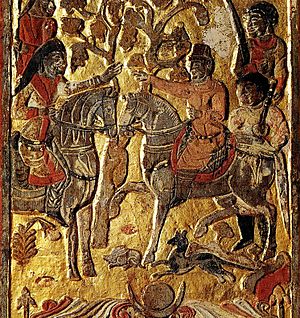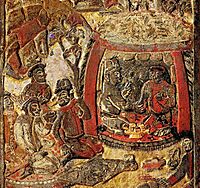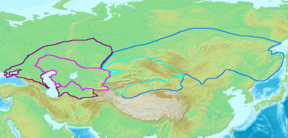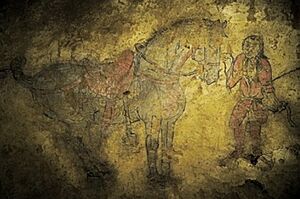First Turkic Khaganate facts for kids
Quick facts for kids
Turkic Khaganate
𐰃𐰓𐰃𐰆𐰴 AsRef: 𐰰𐰇𐰚: 𐱅𐰇𐰼𐰰
|
|||||||||||||
|---|---|---|---|---|---|---|---|---|---|---|---|---|---|
| 552–603 | |||||||||||||
| Status | Khaganate (Nomadic empire) | ||||||||||||
| Capital |
|
||||||||||||
| Common languages |
|
||||||||||||
| Religion | Tengrism, Buddhism | ||||||||||||
| Demonym(s) | Türük Türk |
||||||||||||
| Qaghan | |||||||||||||
|
• 552
|
Bumin Qaghan (first) | ||||||||||||
|
• 599–603
|
Tardu (last) | ||||||||||||
| Yabgu | |||||||||||||
|
• 552–575
|
Istämi (first) | ||||||||||||
|
• 575–599
|
Tardu (last) | ||||||||||||
| Historical era | Post-classical | ||||||||||||
|
• Bumin Qaghan revolts against Rouran Khaganate
|
542 | ||||||||||||
|
• Established
|
552 | ||||||||||||
|
• Göktürk civil war
|
581 | ||||||||||||
|
• Brief re-unification
|
603 | ||||||||||||
|
• Division of Western and Eastern Turkic Khaganates
|
603 | ||||||||||||
| Area | |||||||||||||
| 557 | 6,000,000 km2 (2,300,000 sq mi) | ||||||||||||
| Population | |||||||||||||
|
• 6th century
|
3 million | ||||||||||||
|
|||||||||||||
The First Turkic Khaganate was a powerful empire in Central Asia. It was also known as the First Turkic Empire or Göktürk Khaganate. This empire was started by the Ashina clan of the Göktürks. It began in 552 CE under the leadership of Bumin Qaghan and his brother Istämi.
The First Turkic Khaganate took over from the Rouran Khaganate. It quickly became the main power in the Mongolian Plateau. The empire grew very fast, stretching from Manchuria all the way to the Black Sea. This made it the first empire in Central Asia to cross two continents.
The Göktürks spoke an early form of the Turkic languages. Their first official writings and coins were in Sogdian. This was the first time the name Türk was used for a state. The Old Turkic script was created in the early 500s.
The Khaganate broke apart in 603 CE. This happened after many fights and civil wars. It split into the Eastern Turkic Khaganate and the Western Turkic Khaganate. Later, Tang China conquered the Eastern Turkic Khaganate in 630 CE. They also conquered the Western Turkic Khaganate in 657 CE. A new empire, the Second Turkic Khaganate, rose in 682 CE. It lasted until 744 CE, when the Uyghur Khaganate took over.
Contents
History of the Turkic Khaganate
How the Empire Began
The story of the Turkic Khaganate starts in 546 CE. A leader named Bumin Qaghan attacked the Uyghur and Tiele groups. These groups were planning to rebel against their rulers, the Rouran Khaganate. Bumin expected a reward for his help: a Rouran princess to marry.
However, the Rouran ruler, Yujiulü Anagui, refused. He called Bumin his "blacksmith slave." This might mean the Göktürks were skilled metalworkers. It also suggests they were not equal partners, but rather vassals or allies who had to obey the Rouran.
Bumin was upset by this insult. He then made an alliance with the Western Wei dynasty of China. They both wanted to defeat the Rouran. In 552 CE, Bumin married Princess Changle from Western Wei. Soon after, Bumin defeated Anagui and his Rouran forces. This battle happened north of Huaihuang (near modern Zhangjiakou, Hebei).
Expanding Westward
Bumin was a great leader in both war and diplomacy. He declared himself the Illig Khagan of the new empire at Otukan. But he died just a few months later. His son, Muqan Qaghan, then took over. He went on to defeat the Hephthalite Empire.
Bumin's brother, Istämi (who died in 576 CE), was called the "Yabgu of the West." This western part of the Ashina clan acted almost independently. But the eastern khagan was still seen as the main ruler. In 557 CE, Istämi teamed up with the Sasanian Empire from Iran. Together, they defeated the Hephthalites, who were allies of the Rouran. This war helped the Ashina clan control the important Silk Road.
The alliance with China became even stronger in 568 CE. The Turkic princess Ashina, daughter of Muqan Qaghan, married Emperor Wu of Northern Zhou. He was the emperor of the Xianbei-led Chinese Northern Zhou dynasty.
The Göktürks expanded into Europe in 576 CE. They crossed the Kerch Strait into the Crimea. Five years later, they attacked Chersonesus. Their horsemen rode across the steppes of Crimea until 590 CE. In the south, their borders reached south of the Amu Darya river. This led to conflicts with their former allies, the Sasanian Empire. In 589 CE, the Sasanian Empire attacked and defeated the Türks. But much of Bactria (including Balkh) remained under Ashina control until the end of the century.
Connecting with the Byzantine Empire
The Göktürks were very important in the Byzantine Empire's dealings with the Persian Sasanian Empire. Their first meeting was likely in 563 CE. It involved an event in 558 CE when some of the Turks' "slaves" (the Pannonian Avars) ran away during a war with the Hephthalites.
The second contact happened when a diplomat named Maniah from Sogdia convinced Istämi to send a group to Constantinople. This group arrived in 568 CE. They gave silk as a gift to Emperor Justin II. They also talked about forming an alliance. In 569 CE, a Byzantine group led by Zemarchus visited the Göktürks. This visit went well and likely made their alliance stronger.
Later, in 575–576 CE, another group from Byzantium visited. This time, the new Turkic ruler Turxanthos was not friendly. He was angry because he felt the Byzantines had been dishonest. He made the Byzantine visitors humiliate themselves at Istämi's funeral. This showed that the alliance was breaking down. The Turks felt their expectations from the agreements were not met. They realized the Byzantines might be using them.
-
Turkic horsemen with long hair on the tomb of a Sogdian trader. Around 570 CE in Northern Dynasties, China.
Civil War and Division
Western Gokturk: Lighter area is direct rule, darker areas show sphere of influence.
Eastern Gokturk: Lighter area is direct rule, darker areas show sphere of influence.When the fourth ruler, Taspar Qaghan, died in 581 CE, the empire split. He wanted Muqan Qaghan's son, Apa Qaghan, to be the next ruler. But the high council chose Ishbara Qaghan instead. This caused different groups to form around each leader. Soon, four different people claimed to be the ruler. The Chinese Sui dynasty and Tang dynasty used these rivalries to their advantage.
Istämi's son, Tardu, who led the western Türks, wanted complete independence. He took the title of khagan and led his army east. He wanted to claim the main seat of power, Otukan.
To make his position stronger, Ishbara of the Eastern Khaganate asked the Chinese Emperor Yang of Sui for protection. Tardu attacked Chang'an, the Sui capital, around 600 CE. He demanded that Emperor Yangdi stop interfering in the civil war. In response, Sui diplomacy encouraged Tardu's Tiele vassals to revolt. This led to the end of Tardu's rule in 603 CE. Among the rebelling tribes were the Uyghurs and Xueyantuo.
Eastern Turkic Khaganate
The civil war divided the empire into eastern and western parts. The eastern part, still ruled from Otukan, stayed close to the Sui dynasty. It kept the name Göktürk. The rulers Shibi Khan (609–619 CE) and Illig Qaghan (620–630 CE) attacked China when it was weak. This was during the time when the Sui dynasty was falling and the Tang dynasty was rising.
In 615 CE, Shibi Khan launched a surprise attack. He almost captured Emperor Yang of Sui. But the emperor's wife, Princess Yicheng, sent a warning. This allowed the emperor and empress to escape to a safe city. The Turkic army besieged the city, but Sui reinforcements arrived. Princess Yicheng also sent a false report to her husband about an attack on the khaganate from the north. This made him end the siege.
In 626 CE, Illig Qaghan took advantage of a power struggle in China. He marched towards Chang'an, the Tang capital. On September 23, 626 CE, his cavalry reached the Wei River. Two days later, Tang Taizong met with Illig Qaghan at a bridge. Taizong accused the khan of crossing the border. The khan thought Tang reinforcements had arrived. He also remembered meeting Li Shimin (who later became Emperor Taizong) two years earlier. The khan was afraid and agreed to retreat. This event is known as the Weishui Alliance. The khan later sent horses and sheep as compensation, but Emperor Taizong did not accept them. In total, 67 attacks into China were recorded.
Before mid-October 627 CE, heavy snow fell on the Mongolian-Manchurian grasslands. It covered the ground deeply, making it impossible for animals to graze. This caused many animals to die. Illig Qaghan was eventually defeated by a revolt of his Tiele vassal tribes (626–630 CE). These tribes allied with Emperor Taizong of Tang.
On March 27, 630 CE, a Tang army led by Li Jing defeated the Eastern Turkic Khaganate. This happened at the Battle of Yinshan. Illig Qaghan was captured and sent to Chang'an. The Eastern Turkic Khaganate collapsed. It became part of the Tang dynasty's system of control. Emperor Taizong said he had finally gotten revenge for the dishonor at Wei River.
Western Turkic Khaganate

The Western khagans Sheguy and Tong Yabghu Qaghan formed an alliance with the Byzantine Empire. They fought against the Sasanian Empire. In 628 CE, they defeated the Sasanians. This helped them get back control of the southern borders along the Tarim and Amu Darya rivers. Their capital was Suyab, near modern Tokmok. In 627 CE, Tung Yabghu, with help from the Khazars and Emperor Heraclius, invaded Transcaucasia. This led to them taking Derbent and Tbilisi. In April 630 CE, Tung's deputy Böri Shad sent Turkic cavalry to invade Armenia. There, his general defeated a large Persian force. But Tung Yabghu was killed in 630 CE. This forced the Göktürks to leave Transcaucasia.
The Western Turkic Khaganate was updated with new rules by the Ashina clan (634–639 CE). It became known as the Onoq. This name means "ten arrows." It refers to the ten leaders (shads) of its two main tribal groups. These groups were the Duolu and Nushibi. Their lands were divided by the Chui River. This division led to groups wanting to be separate. Soon, a chieftain named Kubrat broke away from the Khaganate.
The Tang dynasty fought against the khaganate and its vassal states in the Tarim Basin. The Tang campaign against Karakhoja in 640 CE made the Western Turks retreat. They were defeated again in 644 CE and 648 CE. Finally, the Tang general Su Dingfang conquered the Western Turks in 657 CE. Emperor Taizong of Tang was then called the Khagan of the Göktürks in 658 CE.
Under Tang Control
The Tang dynasty kept a member of the Ashina clan as a puppet ruler. This ruler had no real power. In 639 CE, Ashina Jiesheshuai tried to kill Emperor Taizong of Tang but failed. This caused the Tang to move the Türks to a new area. These puppet rulers were not respected by other leaders. By 699 CE, a new group of leaders called the Turgesh had risen.
In 657 CE, the Tang emperor was able to control the Silk Road indirectly, all the way to modern-day Iran. He put two khagans in charge of the ten "arrows" (tribes) of the Göktürks. The five arrows of Tulu ruled the area east of Lake Balkash. The five arrows of Nushipi ruled the land east of the Aral Sea. The Göktürks now used Chinese titles and fought alongside the Chinese in their wars. From 657 to 699 CE, the steppes had many weak and divided rulers. They were always fighting small wars under Tang control.
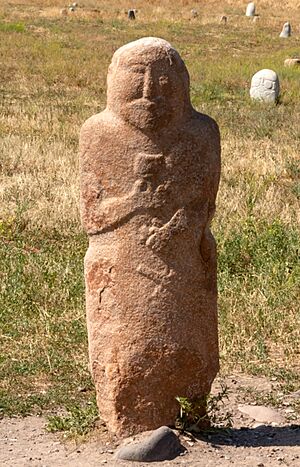
The Second Turkic Khaganate was founded by Ilterish Qaghan. He rebelled against the Tang in 681 CE.
Genetics and Ancestry
Studies of the people from the First Turkic Khaganate show they had different ancestries. On average, their genes were about 62% from Ancient Northeast Asian groups. About 27% came from Western Steppe Herders. And about 11% was linked to the BMAC (an ancient culture).
A sample from the Ashina tribe, the ruling family, was almost entirely from Ancient Northeast Asians (96-98%). This suggests that the spread of Turkic languages happened more through cultural sharing than through large groups of people moving.
Gallery
-
A Shahnameh drawing of Bahram Chobin fighting Bagha Qaghan.
-
Another Shahnameh drawing of Bahram Chobin and Bagha Qaghan fighting.
-
A Turkic Balbal statue from Kyrgyzstan.
See also
- Göktürk family tree
- Turks in the Tang military
- Horses in East Asian warfare
- Kangly
- Orkhon inscription
- Qaghans of the Turkic khaganates
- Timeline of the Turkic peoples (500–1300)
- Ashide



